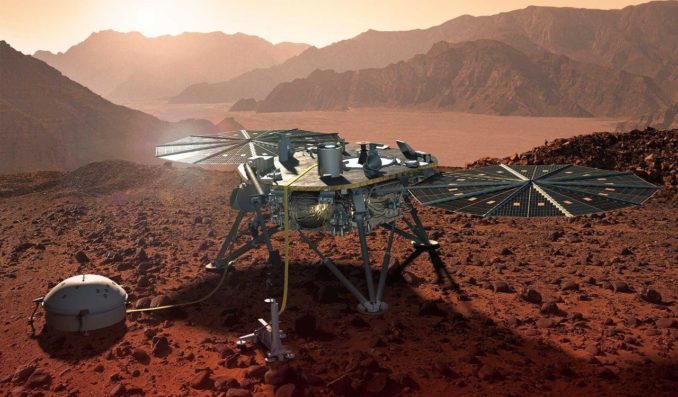Nasa’s Mars InSight Probe Successfully Arrives at the Red Planet
Nasa’s Mars InSight probe has successfully landed on the surface of Mars after a long journey of 300m-mile, that is covered in seven months. InSight – short for “Interior Exploration using Seismic Investigations, Geodesy and Heat Transport,” is an $830 million robot, that has been sent to Mars to know the planet better.
The robot landed at the quietest place on Mars, Elysium Planitia, a vast, smooth lava plain, also called as “the biggest parking”, shortly before 8 pm GMT on Monday. There were cheers and hugs among the scientists at Nasa’s Jet Propulsion Laboratory, in California, when the InSight robot sent the signals of its successful arrival on the planet.

“It was intense, and you could feel the emotion,” said NASA Administrator Jim Bridenstine, on receiving a congratulatory phone call from Vice President Mike Pence. “What an amazing day for NASA,” he added. The robot also sent a picture of itself, soon after a few minutes of its arrival on the surface. Due to the dust, the picture came out to be a bit blurred, but NASA claims that the next pictures will be more clear.
NASA launched the mission on May 5, this year, from the United Launch Alliance Atlas V rocket from Vandenberg Air Force Base in California, unlike the other missions, that were launched from the Cape Canaveral. The robot landed on Mars successfully, after it blasted off its heat shield and fired retro-thrusters to slow its descent when it entered into the thin Martian atmosphere and released a parachute.
The robot will accomplish a two years mission and will be studying more about the core, crust and mantle of the planet. The robot is further focused on researching the climate and the formation of the planed more than 4.6bn years ago. The InSight mission is one of the 40% Mars missions that have been successful in the past. The lander is embedded with a seismometer, that will work as an ear listen to the vibrations on the ground. It is capable of recording a dozen to 100 Marsquakes of magnitude 3.5 or greater, during its two years mission on the planet.
It also consists of a heat probe, that will measure the Mars’ heat rate under the ground. The scientists will also calculate the size of the Mars’ core, with the help of the antenna attached to the robot, that will measure the Mars’ wobbles on its axis. There are a lot more enclosed in the mission that will be revealed in steps after the mission moves further.
Bruce Banerdt, the mission’s lead scientist from JPL, said, “When we look at the crust of Mars, that’s a snapshot into the past, of what the crust of the Earth might have looked like 4.5 billion years ago before it got all busy. It will take about two years to collect the data needed to answer the mission’s “deep questions.” depending on how many quakes Mars has in store.”

Yashica is a Software Engineer turned Content Writer, who loves to write on social causes and expertise in writing technical stuff. She loves to watch movies and explore new places. She believes that you need to live once before you die. So experimenting with her life and career choices, she is trying to live her life to the fullest.